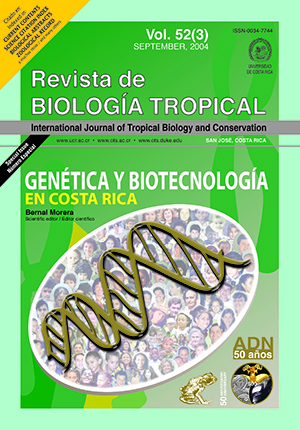Resumen
La mutagénesis ambiental o genética toxicológica es una disciplina que tiene como objetivo estudiar el daño genético que conduce a mutaciones, producido por agentes físicos, químicos y biológicos, identificar estos agentes, analizar sus interacciones y mecanismos de acción. Existen suficientes evidencias experimentales y epidemiológicas que demuestran que el proceso cancerígeno se inicia y se favorece por la presencia de mutaciones en los oncogenes, los genes supresores de tumores y los que codifican para los sistemas de reparación del ADN. Una herramienta valiosa en salud pública y ocupacional es el monitoreo de grupos de población expuestos a agentes potencialmente dañinos para el ser humano. Tiene como objetivo preservar la salud y la calidad de vida en aquellos grupos que son de alto riesgo por la naturaleza de las sustancias a que están expuestos. Se vislumbra al monitoreo del efecto genotóxico en poblaciones expuestas, en conjunto con el análisis de polimorfismos de susceptibilidad, como herramientas clave en la salud pública y ocupacional del futuro, para prevenir la ocurrencia de tumores de origen ambiental y especialmente laboral. En este trabajo se revisan los principales conceptos sobre este tema y se hace referencia a los trabajos realizados sobre exposición laboral a potenciales cancerígenos y a la que existe en el monitoreo de poblaciones expuestas en Costa Rica.
Citas
Ames, B.N. 1979. Identifying environmental chemicals causing mutations and cancer. Science 204: 587-593.
Anónimo. 1994. Occupational cancer in developing countries. IARC Scientific. Publications N°129. Lyon. 191 p.
Anónimo. 1999. The use of short- and medium-term test for carcinogens and data on genetic effects in carcinogenic hazard evaluation. IARC Scientific Publications N°146. Lyon. 536 p.
Au, W.W., C.H. Sierra-Torres, N. Cajas-Salazar, B.K. Shipp & M.S. Legator. 1999. Cytogenetic effects from exposure to mixed pesticides and the influence from genetic susceptibility. Environ. Health Perspect. 104: 579-583.
Au, W.W. 2001. Life style factors and acquired susceptibility to environmental disease. Int. J. Hyg. Environ. Health. 204: 17-22.
Bonassi, S. & W.W. Au. 2002. Biomarkers in molecular epidemiology studies for health risk prediction. Mutat. Res. 511: 73-86.
Castro-Volio, I. & L. Valle-Bourrette. 2002. Chromosomal defects in 34 male homosexuals, half of them with HIV antibodies. Rev. Biol. Trop. 50: 347-353.
Castro, R., V. Ramírez & P. Cuenca. 2004. Análisis de micronúcleos y otras anormalidades nucleares en el epitelio
oral de mujeres expuestas ocupacionalmente a plaguicidas. Rev. Biol. Trop. 52: 207-217.
Creus, A. 2001. Genotoxicidad, mutagénesis y carcinogénesis, pp 17-162. In C. Paz-y-Miño, A. Creus, O. Cabré
& P. Leone (eds.). Genética toxicológica y carcinogénesis. Laboratorio de Genética Molecular y Citogenética Humana. Pontificia Universidad Católica del Ecuador, Quito.
Cuenca, P., V. Ramírez, R. Castro & K. Schosinsky. 1997. Efecto genotóxico de los plaguicidas en una población
costarricense expuesta ocupacionalmente. Informe final PLAGSALUD/OPS. San José. 47 p.
Cuenca, P. & V. Ramírez. 2004. Aberraciones cromosómicas en trabajadoras expuestas ocupacionalmente a plaguicidas. Rev. Biol. Trop. 52: 219-224.
Fabia, J. & T. Thuy. 1974. Occupation of father at time of birth of children dying of malignant diseases. Br. J.
Prev. Soc. Med. 28: 98-100.
Hagmar, L., S. Bonassi, U. Stromberg, A. Brogger, L.E. Knudsen, H. Norppa, C. Reuterwall & The European
Study Group on Cytogenetic Biomarkers and Health. 1998. Chromosomal aberrations in lymphocytes predict human cancer: A report from the European Study Group on Cytogenetic Biomarkers and Health (ESCH). Cancer Res. 58: 4117-4121.
Holly, A., D. Aston & A.D. Khristiansen. 1992. Ewing´s bone sarcoma, paternal occupational exposure and other factors. A. J. Epidemiol 135: 122-129.
ICPEMC. 1983. Screening strategy for chemicals that are potential germ-cell mutagens in mammals. Mutat. Res. 144: 117-177.
Landis, W.G. & M. Yu. 1999. Environmental toxicology. Impacts of chemical upon ecological systems. Lewis. Nueva York. 390 p.
Morales, R. A. 1997. Sustancias químicas cancerígenas en el sector industrial de Costa Rica: el uso de registros
como herramientas de Salud Pública; Rev. Costarric. Salud Pública 6: 11-19.
Phillips, D.H. & S Venitt (eds.). 1995. Environmental Mutagenesis. Bios Scientific. London. 403 p.
Ramírez, V. & P. Cuenca. 2001. Micronuclei frecuency in lymphocytes of individuals occupationally exposed to pesticides. Rev. Biol. Trop 49: 1-8.
Ramírez V. & P. Cuenca. 2002. Daño del ADN en trabajadoras bananeras expuestas a plaguicidas en Limón,
Costa Rica. Rev. Biol. Trop. 50: 507-518.
Reddy, E.P., R.K. Reynolds, E.Santos & M. Barbacid. 1982. A point mutation is responsible for the acquisition of
transforming properties by the T24 human bladder carcinoma oncogene. Nature 300: 149-152.
Schulte, P.A. & F.P. Perera. 1993. Molecular epidemiology. Principles and practices. Academic. Nueva York. 588 p.
Sharpe, C.R, E. L. Franco, B. de Camargo, L.F. Lopes, J.H. Barreto, R.R. Johnsson, M.A. Mauad. 1995. Parental
exposures to pesticidas and risk of Wilms’ tumor in Brazil. Am. J. Epidemiol. 141: 210-217.
Venitt, A & D. Phillips. 1995. The importance of environmental mutagens in human carcinogenesis and germline
mutation. pp 1-17. In D.H. Phillips & S. Venitt (eds.). Environmental mutagenesis. Bios Scientific, Londres.
Vindas, R., F. Ortiz, V. Ramírez & P. Cuenca. 2004. Genotoxicidad de tres plaguicidas utilizados en la actividad bananera de Costa Rica. Rev. Biol. Trop. 52: 197-205.
Vineis, P., N. Malats & P. Boffetta. 1999. Why study metabolic susceptibility to cancer ? pp. 1-4 In P. Vineis, N. Malats, M. Lang, A. d’Errico, N. Caporaso, J. Cuzick & P. Boffetta. Metabolic Polymorphisms and Susceptibility to cancer. IARC Scientific Publications N° 148. Lyon.
Winn, D., L. Robinson, J. Mulvihill, A. Daigle & J. Fraumeni. 1992. A case-control study of the aetiology of Ewing´s sarcoma.Cancer. Epidemiol. Biomarkers Prev. 1: 525-532.
##plugins.facebook.comentarios##

Esta obra está bajo una licencia internacional Creative Commons Atribución 4.0.
Derechos de autor 2004 Revista de Biología Tropical


